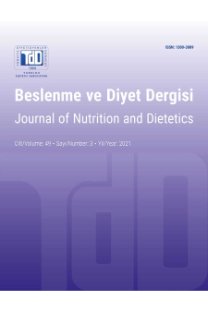COVID-19 Pandemi Döneminde Toplu Beslenme Servisi Yapan Farklı Kurumların Menülerinin Değerlendirilmesi
Evaluation of the Menus of Food Service Systems of Different Institutions During COVID-19 Pandemic
___
- 1. Moscatelli F, Sessa F, Valenzano A, Polito R, Monda V, Cibelli G, et al. COVID-19: Role of nutrition and supplementation. Nutrients. 2021;13(3):976.
- 2. Parthasarathy P, Vivekanandan S. An extensive study on the COVID-19 pandemic, an emerging global crisis: Risks, transmission, impacts and mitigation. J Infect Public Health. 2020;14(2):249-10.
- 3. Yılmaz SK, Eskici G. Evaluation of emotional (depression) and behavioral (nutritional, physical activity, sleep) status of Turkish adults during the COVID-19 pandemic period. Public Health Nutr. 2020;24(5):1-21.
- 4. T.C. İçişleri Bakanlığı. Koronavirüs Tedbirleri Konulu Ek Genelge. 2020. Erişim: https://www.icisleri.gov.tr/81- il-valiligine-koronavirus-tedbirleri-konulu-ek-genelgegonderildi- 08-09-20. Erişim tarihi: 11 Haziran 2021.
- 5. T.C. Sağlık Bakanlığı. COVID-19 Salgın Yönetimi ve Çalışma Rehberi Bilimsel Danışma Kurulu Çalışması. 1 Ekim 2020. Erişim: https://covid19.saglik.gov.tr/Eklenti/41415/0/ covid19-toplumdasalginyonetimirehberipdf.pdf Erişim tarihi: 11 Haziran 2021.
- 6. Erdem İ. Koronavirüse (COVID-19) karşı Türkiye’nin karantina ve tedbir politikaları. Turkish Studies. 2020;15(4):377-11.
- 7. Barman A, Das R, De PK. Impact of COVID-19 in food supply chain: Disruptions and recovery strategy. Current Research in Behavioral Sciences. 2021;2:100017.
- 8. Ayseli YI, Aytekin N, Buyukkayhan D, Aslan I, Ayseli MT. Food policy, nutrition and nutraceuticals in the prevention and management of COVID-19: Advice for healthcare professionals. Trends Food Sci Technol. 2020;105:186-13.
- 9. Wei CV, Chen H, Lee YM. Factors influencing customers’ dine out intention during COVID-19 reopening period: The moderating role of country-of-origin effect. Int J Hosp Manag. 2021;95:102894.
- 10. Kim JJ, Kim I, Hwang J. A change of perceived innovativeness for contactless food delivery services using drones after the outbreak of COVID-19. Int J Hosp Manag. 2021;93:102758.
- 11. Fiori F, Bravo G, Parpinel G, Malavolta R, Lazzer S. Relationship between body mass index and physical fitness in Italian prepubertal schoolchildren. PLoS One. 2020;15(5):0233362.
- 12. Childs CE, Calder PC, Miles EA. Diet and immune function. Nutrients. 2019;11(8):1-9.
- 13. U.S. Food and Drug Administration (FDA). Menu Labeling Rule Key Facts for Industry. 2018, Available at: https://www.fda.gov/Food/GuidanceRegulation/ G u i d a n c e D o c u m e n t s R e g u l a t o r y I n f o r m a t i o n / LabelingNutrition/ucm515020.htm Accessed June 21, 2021.
- 14. Merdol TK. Toplu Beslenme Servisi Yapılan Kurumlar İçin Standart Yemek Tarifeleri. 2019, Ankara: Hatiboğlu Yayıncılık.
- 15. T.C. Sağlık Bakanlığı. Türkiye Beslenme Rehberi (TÜBER) 2015. Sağlık Bakanlığı Yayınları, Ankara, 2016.
- 16. European Food Safety Authority (EFSA). Review of labelling reference intake values-scientific opinion of the panel on dietetic products, nutrition and allergies on a request from the commission related to the review of labelling reference intake values for selected nutritional elements. EFSA J. 2009;7:1008.
- 17. Dikmen D, Pekcan G. Besin ögesi örüntü profili: Toplu beslenme hizmeti veren kuruluşlarda uygulanan menülerin değerlendirilmesi. Bes Diy Derg. 2013;41(3):234-7.
- 18. Drewnowski A. Defining nutrient density: Development and validation of the nutrient rich foods index. J Am Coll Nutr. 2009;28(4):421-5.
- 19. Hess JM, Slavin JL. Healthy snacks: Using nutrient profiling to evaluate the nutrient-density of common snacks in the United States. J Food Sci. 2017;82(9):2213-7.
- 20. Streppel MT, Sluik D, van Yperen JF, Geelen A, Hofman A, Franco OH, et al. Nutrient-rich foods, cardiovascular diseases and all-cause mortality: The Rotterdam study. Eur J Clin Nutr. 2014;68(6):741-6.
- 21. T.C. Sağlık Bakanlığı Halk Sağlığı Genel Müdürlüğü. Toplu Beslenme Sistemleri (Toplu Tüketim Yerleri) İçin Ulusal Menü Planlama ve Uygulama Rehberi, Sağlık Bakanlığı Yayınları, Ankara, 2020.
- 22. Gupta S, Hawk T, Aggarwal A, Drewnowski A. Characterizing ultra-processed foods by energy density, nutrient density, and cost. Front Nutr. 2019;6:70.
- 23. Glanz K, Hersey J, Cates S, Muth M, Creel D, Nicholls J, et al. Effect of a nutrient rich foods consumer education program: Results from the nutrition advice study. J Acad Nutr Diet. 2012;112(1):56-7.
- 24. Drewnowski A. The Nutrient Rich Foods Index helps to identify healthy, affordable foods. Am J Clin Nutr. 2010;91(4):1095-6.
- 25. Kalyoncu ZB, Çetiner Ö, Balcı TN, Eroğlu ZB, Kutluay- Merdol T. Perspectives of healthy eating environment on campus: A qualitative study in a private university in Ankara, Turkey. Bes Diy Derg. 2020;48(3):18-20.
- 26. Chesnut WM, MacDonald S, Wambier CG. Could diet and exercise reduce risk of COVID-19 syndemic? Med Hypotheses. 2021;148:110502.
- 27. Lazarus G, Audrey J, Wangsaputra VK, Tamara A, Tahapary DL. High admission blood glucose is an independent risk factor of poor prognosis in COVID-19: A systematic review and dose-response meta-analysis. medRxiv. 2020.
- 28. Lange KW, Nakamura Y. Lifestyle factors in the prevention of COVID-19. Glob Health J. 2020;4(4):146-7.
- ISSN: 1300-3089
- Yayın Aralığı: 3
- Başlangıç: 1972
- Yayıncı: Türkiye Diyestisyenler Derneği
Çocuklar ve Aileleri için Yeme Farkındalığı Müdahale Programı’nın Türk Kültürüne Uyarlama Çalışması
Eda Köksal, Betül Kocaadam Bozkurt
Herediter Tirozinemi Tip-1 ve Tip-1 Diabetes Mellitus Birlikteliğinde Diyet Yönetimi: Olgu Sunumu
Can Celiloğlu, Fatma Derya Bulut, Semine Özdemir Dilek, Bilgin Yüksel, Deniz Kor, Neslihan Önenli Mungan, Tuğçe Kartal, Burcu Köşeci, Esra Kara
Polikistik Over Sendromu, Obezite ve Melatonin: Etiyolojik Bakış Açısı
Makbule Gezmen Karadağ, Büşra Başar Gökcen
Multipl Sklerozlu Hastalarda Güncel Diyet Yaklaşımları
Fonksiyonel Gastrointestinal Bozukluklarda Beslenmenin Önemi ve Diyetisyenin Rolü
Perim F. Türker, Handan Öğretir
Mevlüde Kızıl, Damla Gümüş, Sümeyra Sevim, Gülsüm Gizem Topal
Mustafa Volkan YILMAZ, Özlem Özpak Akkuş, Esma Asil
Emine Akal Yıldız, Nurbanu Öztayıncı, Aylin Açıkgöz Pınar, Hülya Gökmen Özel
